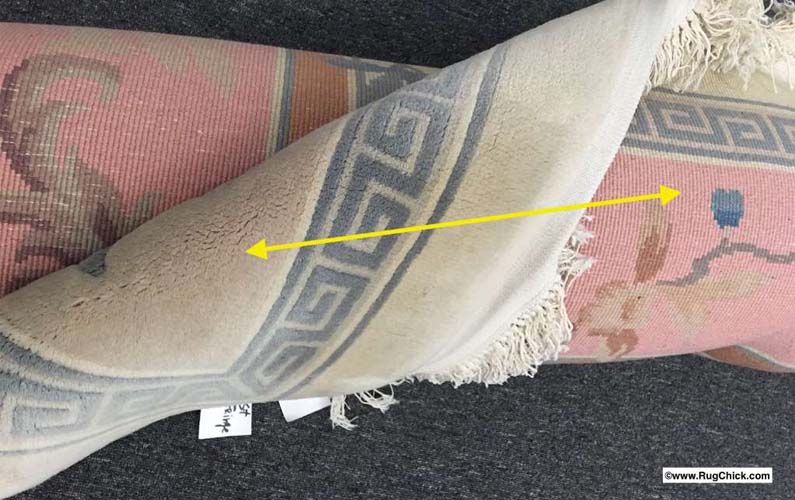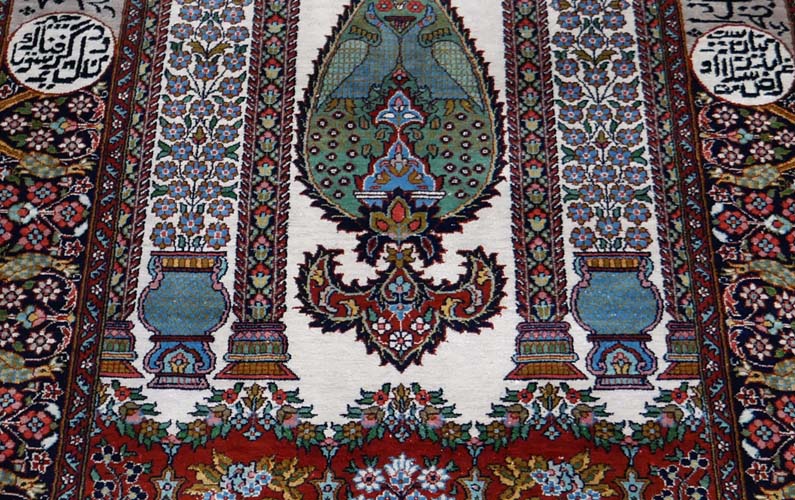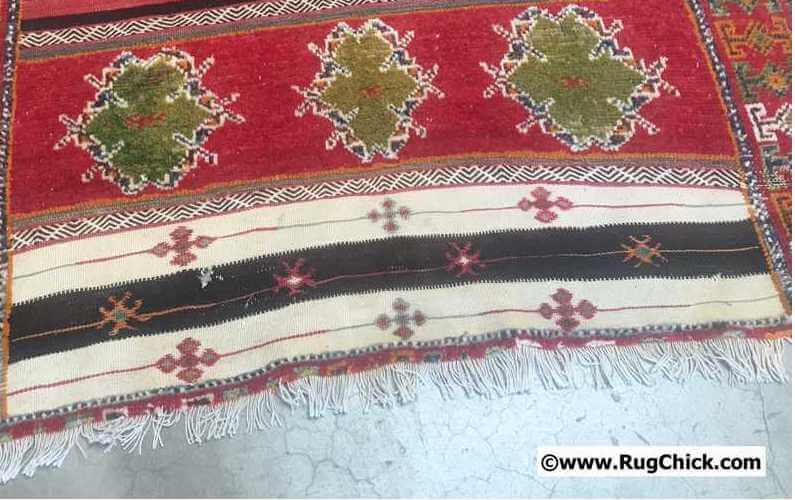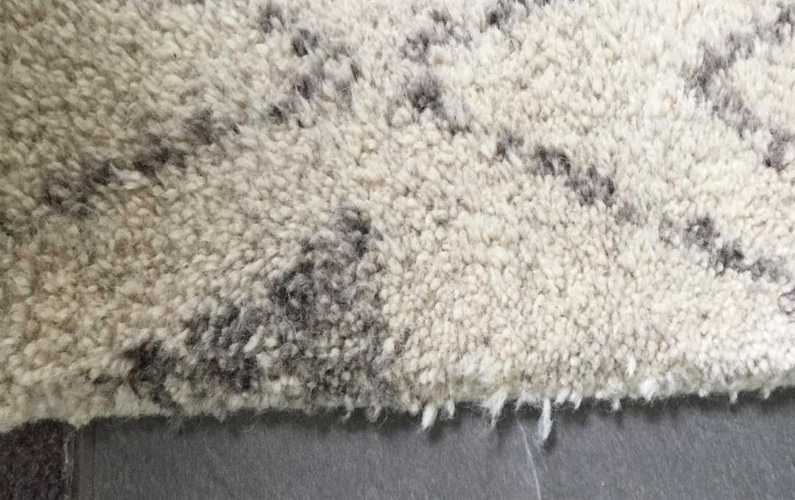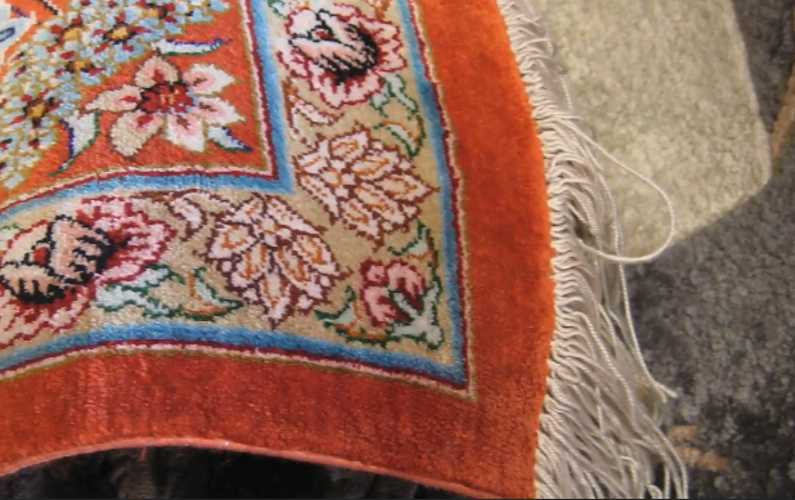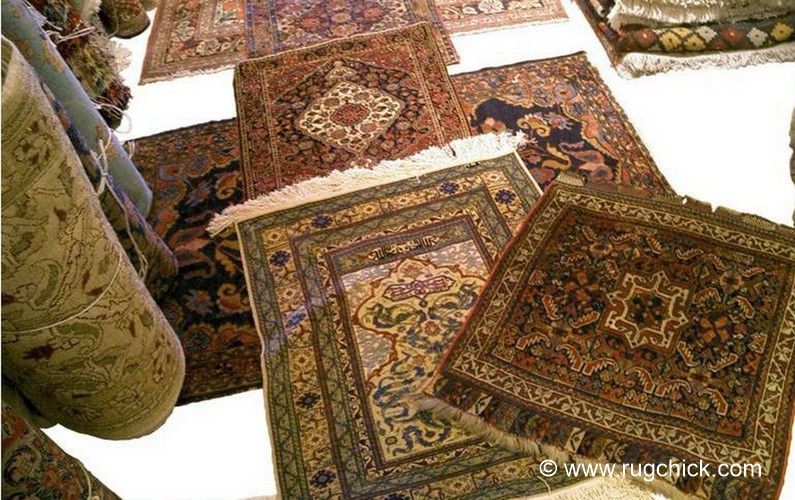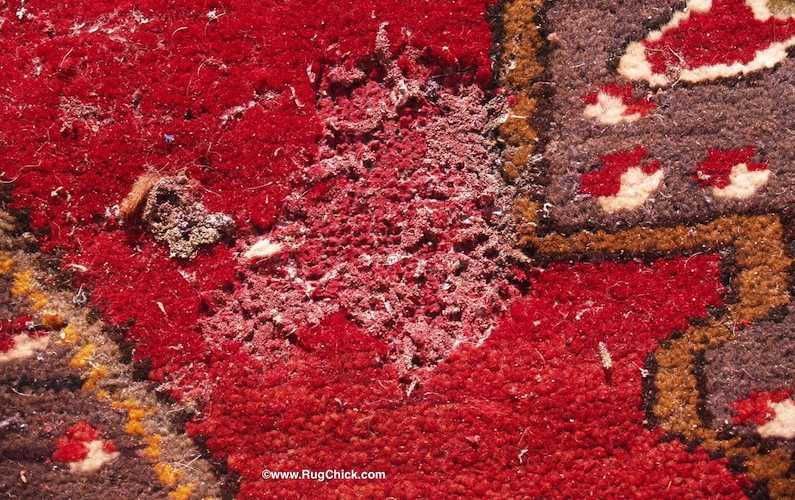FAKE silk rugs. What you need to know.
“I know better.”
That is EXACTLY what I said in my head as I was looking at a cute shiny, smooth blue top at Nordstrom…
…and saw the label said “60% rayon.”
You see, I know that rayon (also sold as viscose) is one of the weakest fibers out there. It’s one of the fibers that is used to create artificial silk.
But it’s weak, it yellows, it loses color, and it ages and gets ugly FAST. It may look like silk to an inexperienced eye in the beginning, but it does not have the strength, vibrancy, and feel of real cultivated silk. Side by side silk will look great after years, and rayon will not.
I knew better… but I was rationalizing the purchase. My head said that I could hand wash it gently. That I could avoid wringing it, or using any high steam or heat when ironing it. That I am a fiber and fabric care expert, so I could handle this.
But alas, I’ve worn the top once, and washed it once, and the fabric is no longer smooth – there are breaks in it already, and a little less sheen. And no one to blame but myself. That makes me mad. Almost as mad as the fact that even though rayon is “fake silk” to help designers get product made cheaper – that they don’t bother to make the tops any cheaper. Rayon is all over the place in clothes today. And not cheap to buy clothes.
LAME.
And we are seeing it in RUGS. The bigger issue here being that rayon and viscose cannot stand up to the foot traffic or soil in a typical home.
Double LAME.
So – if you are a buyer beware. And if you are a rug cleaner, here are some tips and facts about artificial silk rugs for you.
HOW TO IDENTIFY “ARTIFICIAL SILK” RUGS? WHAT TO LOOK FOR.
As I mentioned in the previous post on Real Silk rugs – high quality silk rugs are not only very thin and pliable, but also incredibly detailed due to some very high knot counts per square inch.
Take a look at this corner again, of a real silk rug – it’s thin, and detailed design.

Real silk rug. Hand woven.
Then take a look at a typical Art Silk rug, this one from China, and it’s thick, the pile color is flat looking, no sheen of a true silk rug.
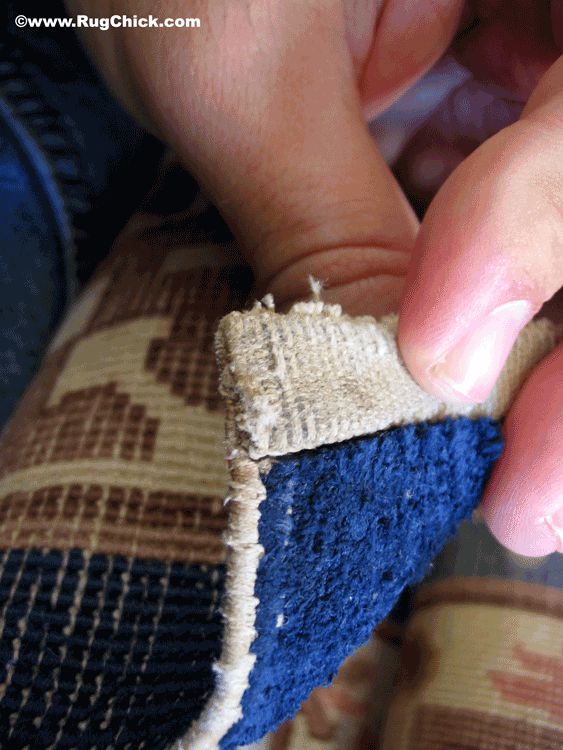
Art (artificial) Silk rug. Folded over corner, and thicker pile.
The Art Silk category is sometimes also referred to as Faux Silk (that’s the fancy sounding French word for FAKE). =)
The most problematic of this category are the ones made of rayon (also known as viscose) – which as I mentioned is an incredibly weak fiber. I’ve mentioned in the past that viscose is the sausage of the fiber world, as it’s chemically reprocessed cotton by-products lumped together and spun into a fiber for the weaving process.
You will find these rugs today coming out of China, Europe (Belgian machine woven product), and in the US (as highlights in some machine woven wool rug products).
You will also find it in product from China where it is blended with real silk by-products. Not blended with quality cultivated silk, but poor quality wild silk.
Cultivated silk is product from silk worms with a mulberry or otherwise controlled diet, where the cocoons are boiled and unraveled into ONE single continuous filament that is incredibly strong and with intense sheen. (Sorry but yes the worms die in this process.)
Wild silk is product from silk worms with no controlled diet, and where the worms bust through their cocoons, so the fibers are broken. Instead of one single filament, it is broken pieces that are spun together into a thicker, but weaker, thread for weaving.
Wild silk is similar to rayon in that it is broken staple fibers spun to create something that can be used for weaving. They will blend this “reject” quality silk with rayon so that they can get away with technically calling the rug “silk.” They also will sometimes use the excess silk waste from a real silk rug weaving to spin into these Art Silk knock-off’s.
Think about it – that is like taking the lint from your lint filter in your clothes dryer and trying to spin that waste into some fiber to create a new top for yourself. It’s meant to be thrown away, and not reused like rayon is.
And so with these rugs you will see shedding that looks almost like a cat has clawed the face of the rug, like this:
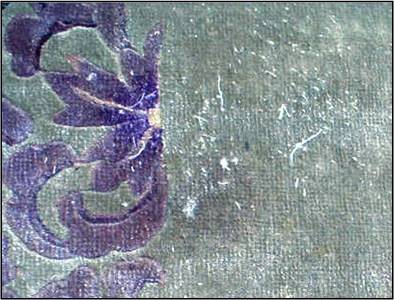
Artificial Silk rayon rug with shedding of fibers.
Your fiber test on these rugs will give you mixed results. The chemical test will show some dissolving (from the crappy but technically “real” silk) but also a lack of dissolving from the rayon. And the burn test will give you mixed up ash and smell because you have a blend of protein and cellulose fibers.
You will get frustrated trying to give a definitive answer.
Though many of these “problem” Artificial Silk rugs are coming from China, it does not mean that all Chinese rugs are not quality rugs. There is actually some excellent quality rugs coming out of China. In fact, EVERY country that has weaving will have the extreme examples of mediocre and magnificent rugs coming out of it.
Here’s a mediocre Artificial Silk rug from China. Note the flat color, and the shaggy looking pile.
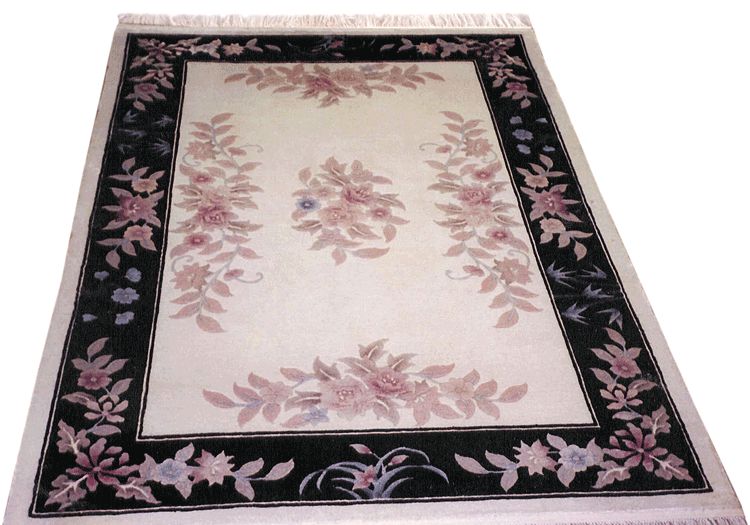
Artificial Silk blend from China – rayon and crummy silk blend.
Now here is a magnificent piece from China – true cultivated silk:
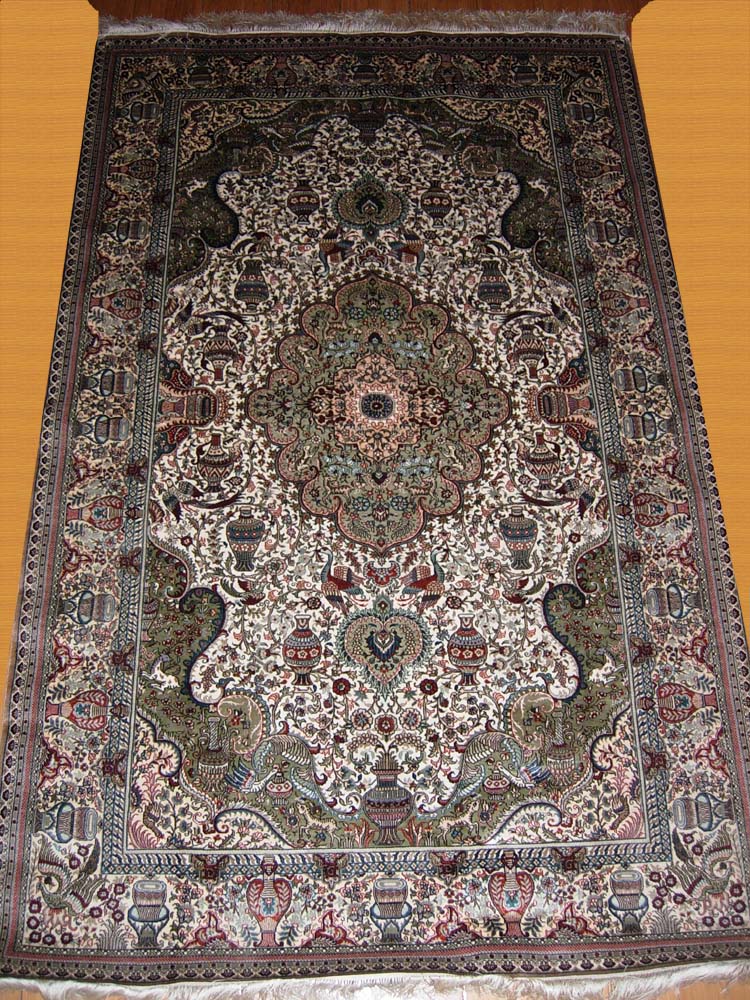
Cultivated high quality silk hand woven rug from China
If you want to see other beautiful silk rugs from China, a great website to visit is the China Silk Carpet site.
Even in the photos you can see the difference in the fiber sheen, and absolutely the level of detail of one versus the other. This is why experienced rug cleaners can immediately identify a fake from a real one, because it’s obvious. Even when dirty, you can tell the difference.
Here is a dirty Artificial Silk rug from China:
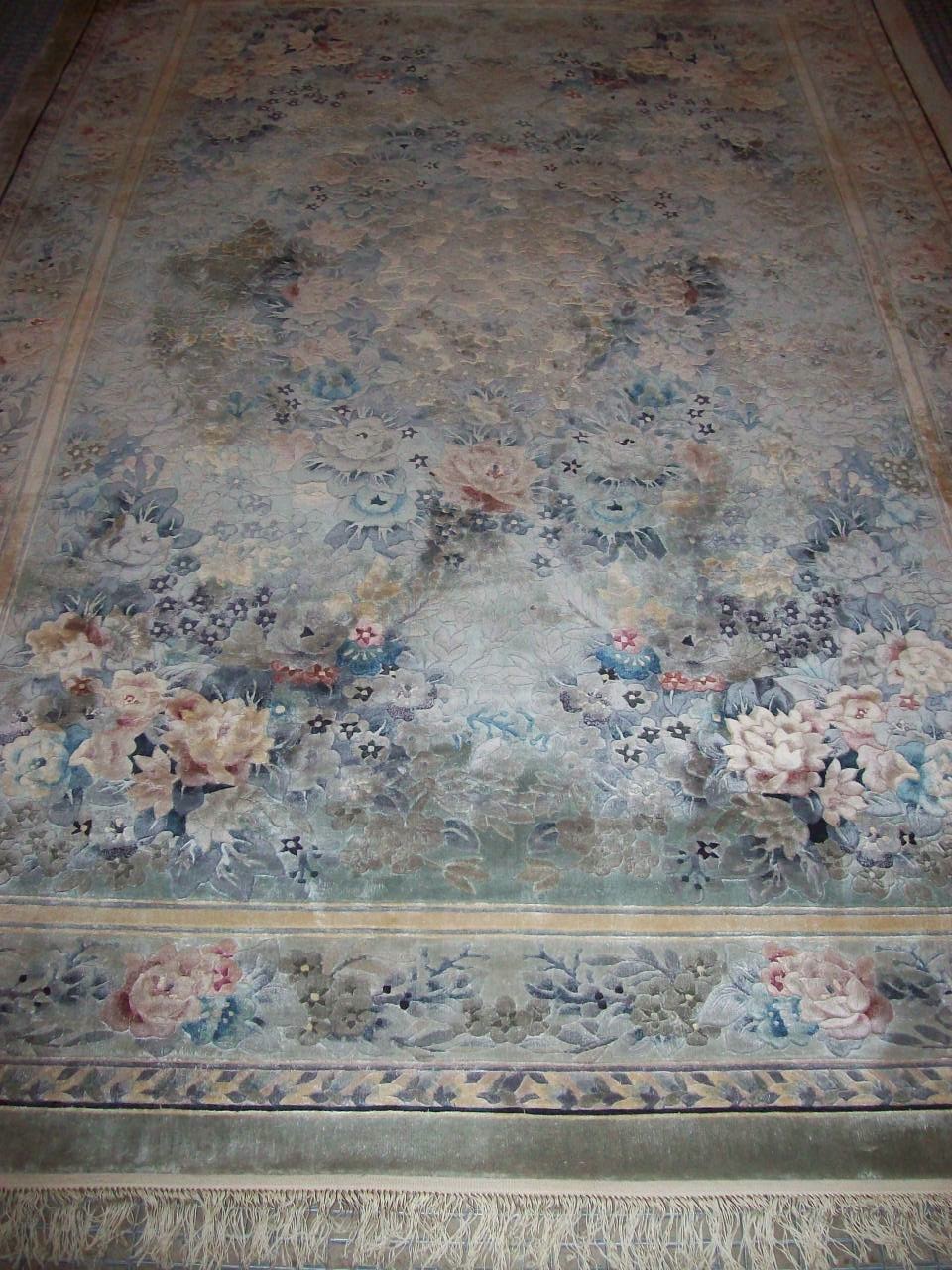
Artificial Silk rug needs to be cleaned. Blend of rayon and wild silk. Folded over ends with fringe tassels strung into the folded edges.
Here is a real silk rug from Iran, and note how the back of the rug shines.

Real silk rug from Iran – note the detail of the design.
You will also see Artificial Silk rugs coming from Turkey, though these rugs are mercerized cotton rather than rayon, and they are much sturdier construction. Generally you will see these as Artificial Silk prayer rugs, like this rug:
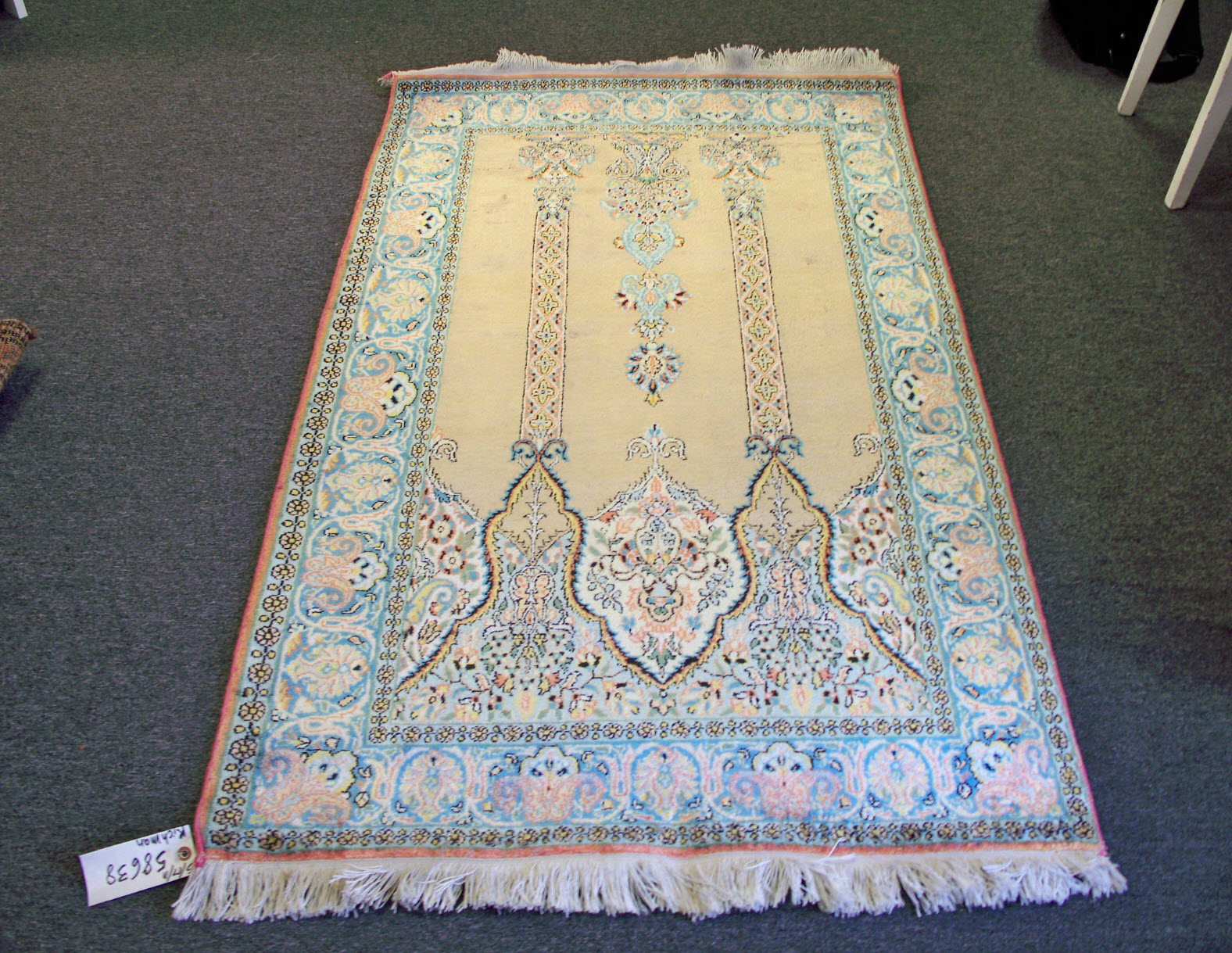
Turkish mercerized cotton Art Silk rug.
This is not a bad looking piece at all, and will last the owner decades. The mercerized cotton fibers do not shed like rayon, and the rugs wash up well and last well under foot traffic. So you get the general “look” of real silk without having to pay thousands of dollars for the rug. But alas, it is not a REAL silk prayer rug like this one:

Real silk prayer rug.
Here is a caption from the China Silk Carpet site regarding silk rug weaving:
It will take one girl about half a year to make a 2×3 ft carpet of 300 lines (90,000 knots per square foot), 1.5 years to weave a 2×3 ft silk carpet of 500 lines (250,000 knots per square foot), two years to knot a 2×1.5 feet silk carpet with 800 lines (640,000 knots per square foot) and 3 years to make a 1.2×1.5 feet silk carpet with 1000 lines(1000,000 knots per square foot). The silk thread used to knot top quality carpet is as thin as a hair. When knotting, weavers even need to use magnifier. The work is so harmful to weavers’ eyes that they seldom can make the second same piece. So this kind of silk carpet is named “soft gold”.
In today’s commodity market of making rugs cheap to sell more of them, there is more demand for the Artificial Silk rugs than the real deal. This is why cleaners see more and more of them to clean today.
The “problem” Artificial Rugs will be the ones made of rayon/viscose, or blends of bad wild silk and rayon spun together coming from China, the cheap viscose Belgian machine made rugs, as well as some American Karastan rugs that are using viscose as “silk highlights” in some of their machine woven rugs.
The mercerized cotton rugs from Turkey are (in our experience) not a problem at all to clean. They wash up great:
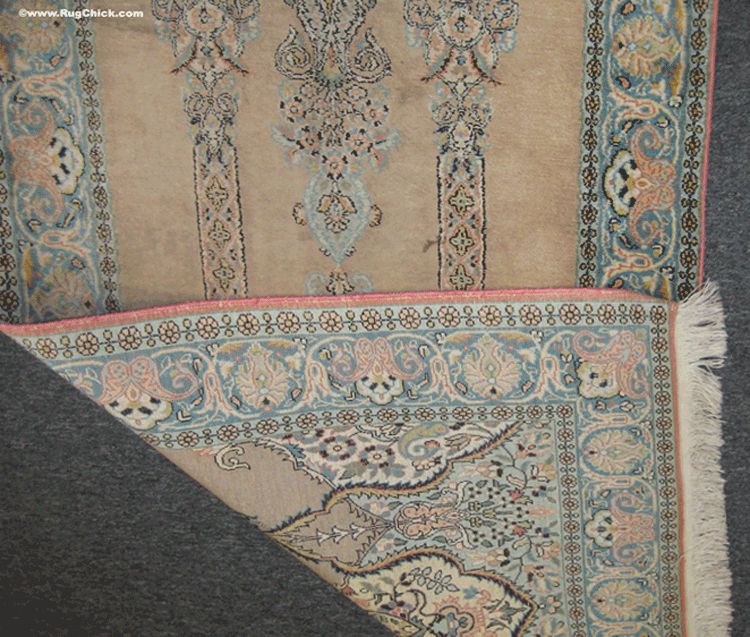
Turkish Art Silk (before wash)
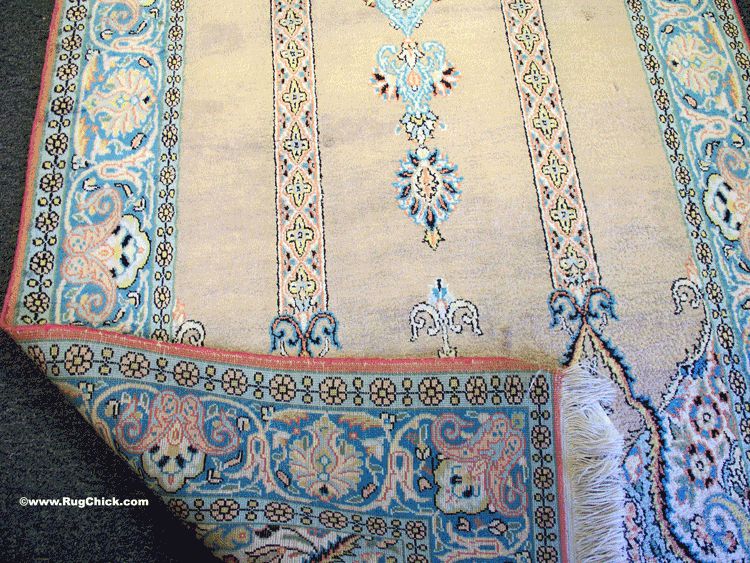
Turkish Art Silk (after wash)
These are the problems cleaners will see with these rayon/viscose rugs Art Silk rugs, and solutions to help minimize the rug disasters that often come with these inferior grade rugs.
ART SILK PROBLEM: DYES THAT BLEED AND FADE.
These viscose rugs like to bleed.
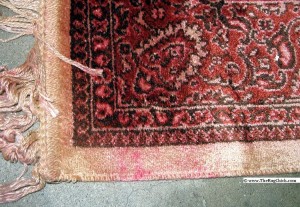
Bled corner of a Belgian machine made viscose Art Silk rug.
As part of your pre-inspection process, a fiber and dye stability test should be done. Your dye stabilizing solution should be tested to see if it will in fact stabilize the dyes during your cleaning process.
Sometimes, when the dyes are too inferior to be “cleanable” – you may need to clean the rug as you would tricky fine fabric, so literally cleaning it with an upholstery hand tool that has excellent moisture control and will not “mark up” the fibers. I like the Upholstery Pro for this type of work.
ART SILK PROBLEM: FIBERS THAT YELLOW.
Rayon likes to yellow.
Here is a rayon blend rug that was cleaned in the home improperly. (Rugs should NEVER be cleaned on location in the home.) Look at how badly the rug yellowed. A piece of white paper is placed in the middle to show the difference before the cleaning of how bad the yellowing/browning occurred. (The rug cleaner thought he would have to buy this rug because of his cleaning errors.)
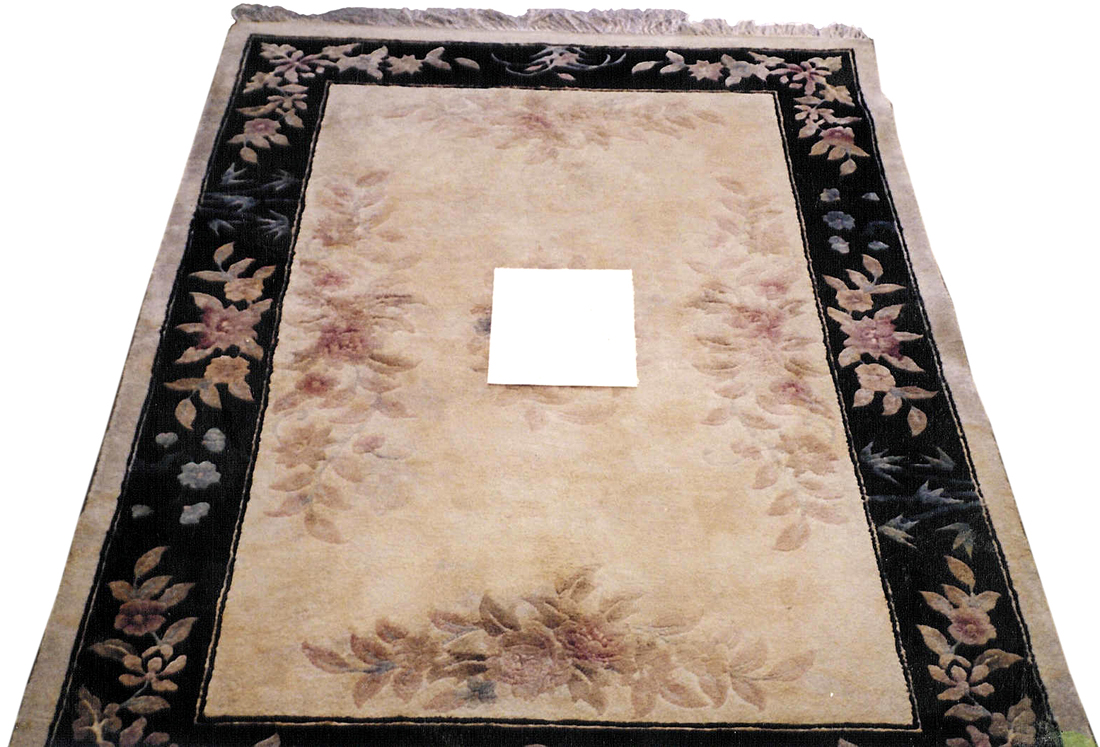
Inexperienced rug cleaner browns out a rayon Art Silk rug.
Notice how bad the cellulose browning is. You really cannot see the colors in the flowers in the field of this rug.
Once the rug was properly washed – TWICE – and given an acid rinse to help reverse the browning and remove the heavy application of the alkaline cleaning solutions used in the improper cleaning – the colors and the white of the rug came back to life.
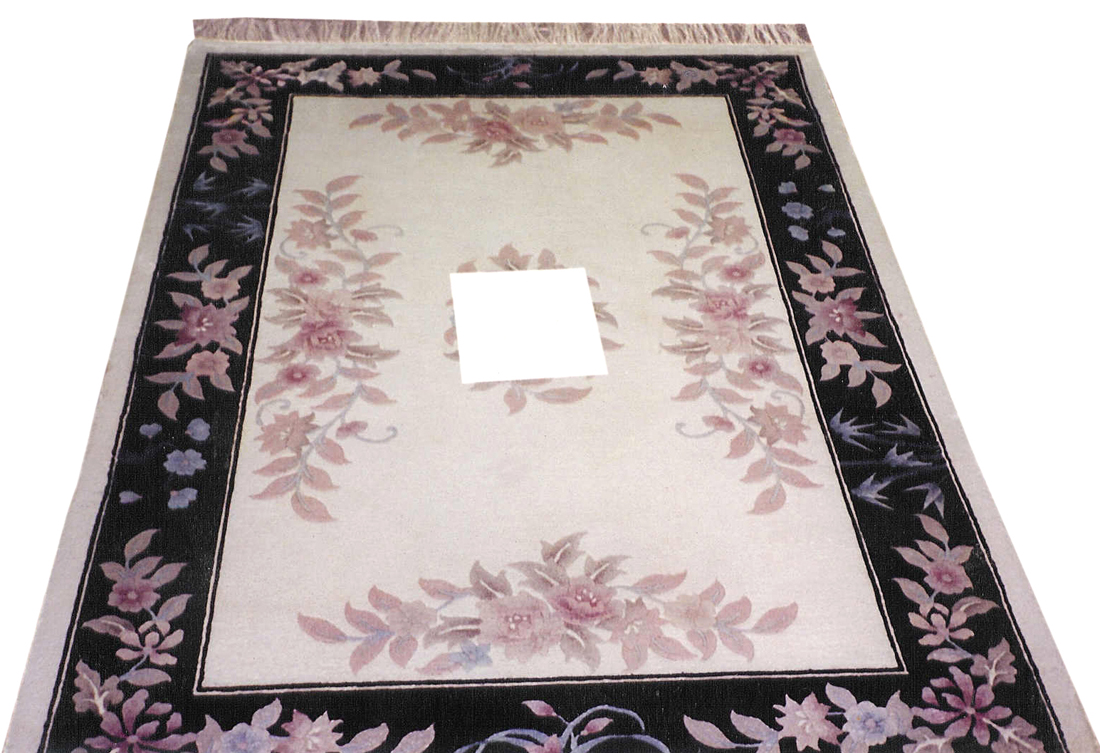
Several washes helped to reverse the damage.
Professionally trained cleaners understand that cotton by-products have a tendency to brown/yellow under certain circumstances. To help minimize yellowing of rayon rugs:
– Wash thoroughly. (If you are able to safely clean – i.e. the dyes are colorfast – then wash so that you can remove the soil. Wicked up soil from a surface cleaning by on-location equipment can sometimes be mistaken for “browning” when it’s just simply still dirty. Wash rugs in plant whenever possible.)
– Use a pure acidic rinse. (This helps to remove cleaning residue and helps to minimize browning or yellowing of rayon.)
– If possible, dry the rug face down. (This will concentrate any browning or yellowing of the rayon to the BACK of the rug instead of the front. Make sure the rug is properly groomed prior to being placed face down on a CLEAN drying surface. Use air movers to speed up the drying process. My favorite quick drying air movers are the Drieaz Studebaker Airpaths.)
ART SILK PROBLEM: FIBERS THAT SHED AND BREAK.
With rayon (viscose) Artificial Silk rugs, there is no way to stop the shedding. These are loose fibers spun together. You can vacuum up the loose pieces, but the shedding will always be a problem exaggerated by any type of regular foot traffic on these rugs.
Washing will wash away some of the fiber pulls. You will want to use a soft brush for the agitation during the cleaning process so that you can minimize the shedding. If your cleaning process incorporates a wand or hand tool, it would be important to have a teflon glide so that you do not leave marks in the fibers during any extraction strokes.
If you are the type of cleaner who likes to use bonnets on rugs, it will be too aggressive for this rug – so be warned.
For regular maintenance, a beater bar upright vacuum will be too aggressive for a fiber as weak as rayon is. Recommend that they use a canister vacuum, or the upholstery vacuum attachment on their machine to regularly “dust” the rug. And let your client know that it IS okay to clip the pulls off, or pull them off. (Sometimes a big lint roller can pull away more of them quicker.) These fibers are already ready to leave the rug, so the client is not going to harm their rug.
It is already a damaged product by the nature of how and what it’s made of. It’s what happens when you cut corners to create a cheap rug, so they need to become accustomed to having a rug that sheds.
ART SILK PROBLEM: FIBERS THAT GET STIFF.
Artificial silk fibers may have a tendency of getting stiff after a cleaning. This can be groomed out with a brush, by slowly brushing against the grain, and then with it. (This brushing backwards and then with the fibers helps release the stiffness and helps it to lay soft again.)
A good rinse in the wash process usually alleviates this stiffness problem, as most matting and stiffness with rayon comes from the rug still having some soil and residue still in its fibers.
Some cleaners will lightly mist a fabric softener mixed with warm water onto the damp surface of these rugs (and some silk rugs) to help soften the fibers stiffness. Just take care to not leave too much of this residue behind. Tacky residue on a rug can lead to resoiling problems.
ART SILK PROBLEM: INK STENCILING THAT BLEEDS OUT.
This is not a common problem, but I’ve seen more than a few incidents with Artificial Silk rugs having stenciling problems. In this case, ink is used to cartoon the design element placement for the weavers and when the rug is washed the ink can bleed out. Because these stencil marks are often in a color like bright pink or blue, they can suddenly wick up and shock an unwary rug cleaner.
Since most rugs are quickly washed before they are sent off to sell, you should be able to see warning signs of stenciling that have already bled onto the back side. Note the pink ink lines on the back of this rayon Art Silk rug:
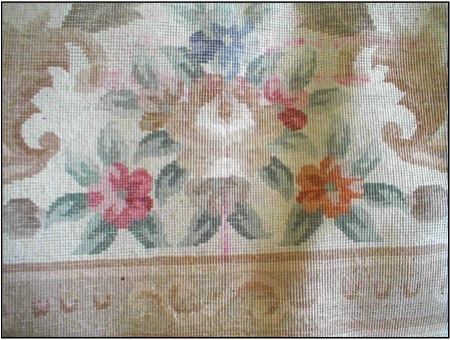
Artificial Silk – stencil ink noticeable on back.
If the rug was not washed before going to market, or if your client has not spilled on the rug enough to give you some pink or blue ink clues, then you may not discover the problem until it’s too late. You can try to grin open the fibers from the front to see if you can locate any ink on the foundation fibers. (Stenciling is a common problem in hooked rugs, and you can see how to grin those rugs to find this problem in a post I did on this exact problem.)
Your dye stabilizing solution will not work to stabilize ink, so this becomes a dangerous cleaning scenario.
Sometimes washing the rug quickly and drying the rug face down can concentrate the ink to the back side of the rug, but there are no guarantees. If the rug owner will not release you from liability on this rug cleaning, then you may have to turn the rug away… or opt for a less-than-thorough cleaning with a dry compound cleaning method, or other low-moisture cleaning method.
Rugs really should be washed, but in this situation where the inferior construction presents dangers of ruining the rug with a proper wash, you may have to choose an improper surface cleaning method because it is your only choice other than simply leaving the rug filthy.
However, because Artificial Silk rugs should be inexpensive you might recommend to the owner of a rug that cannot be safely and thoroughly cleaned to simply buy a new one. That would be better than never cleaning the stenciled one they have. And then you can give them recommendations on choosing a better quality rug – such as a wool rug if they want a sturdy rug on their floor that will last them forever… or a real silk rug to mount on the wall as a beautiful piece of weaving art for their home.
Hope this post helps keep those of you who clean Art Silk rugs out of trouble. Happy rug washing!
– Lisa


